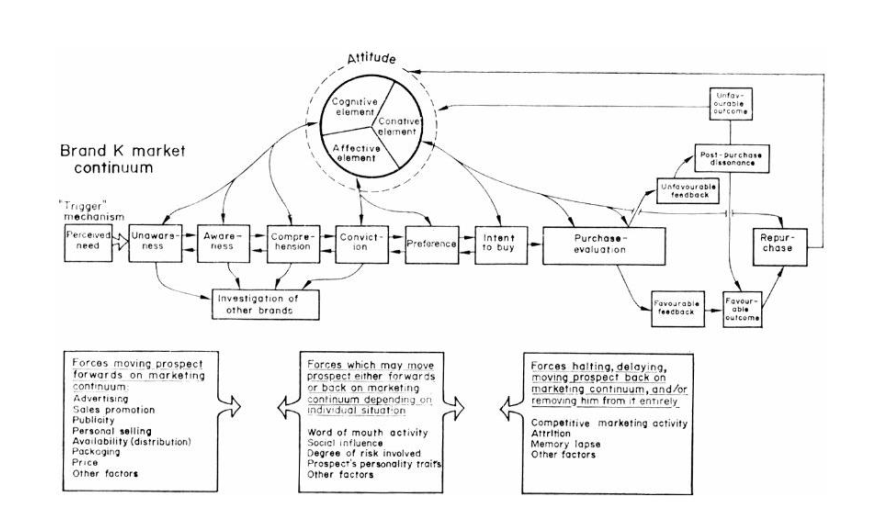Customer Journey & Attribution Modelling - How can Customer Journeys be effectively mapped and applied?
Guide based on a research project exploring effective customer journey mapping methodologies and their practical application in digital marketing campaigns.

Research Overview
In today’s hyper-competitive digital landscape, understanding your customer’s path to purchase isn’t just an advantage—it’s essential for survival.
This research project investigated effective methodologies for customer journey mapping (CJM), combined with advanced attribution modeling to transform how businesses understand and optimize their customer experience.
The Challenge
Most businesses are flying blind when it came to understanding their customers’ true journey. Some are using outdated, linear models that fail to capture the complex, multi-touchpoint reality of modern consumer behavior. Others use journeys created through their own sales and marketing teams’ assumptions, thus lacking objectivity and inherently include their own biases. Key problems included:
- Ineffective Attribution Models: 85% of businesses relied on last-touch attribution, missing 70% of valuable customer interactions
- Linear Journey Assumptions: Traditional mapping ignored the non-linear, looping nature of actual customer behavior
- Disconnected Touchpoint Strategy: No cohesive approach to managing experiences across multiple channels
- Data Silos: Customer insights are often trapped in individual platforms with no unified view
Research Objectives
Research Question
Because of this, the paper is based on the works and conclusions of 60+ academic sources, peer-reviewed research articles, marketing manuals, books and practitioner guides on the topics of marketing, marketing research, attribution theory and models, data science and AI models.
Goals
The project aimed to present further in-depth perspectives on the theoretical origins and perspectives of Customer Journey and methods through which it can be applied in real-life environments. In addition to this general goal, the paper had a number of sub goals:
- Conduct literature review on the topic of Customer Journeys and their role in marketing research
- Customer Journey Mapping methods and their critical analysis
- Attribution models and their roles in creating Customer Journeys
- Implementation and use of Customer Journeys in general business environments
- Customer Journey best practices for B2C and B2B companies
Methodology
Literature Review
The paper is based on the works and conclusions of 64 academic sources, peer-reviewed research articles, marketing manuals, books and practitioner guides on the topics of marketing, marketing research, attribution theory and models, data science and AI models. All of these sources are available in the assignment’s bibliography section. The comprehensive analysis of the existing research includes:
- Academic papers on customer behavior
- Industry reports on attribution modeling
- Case studies from leading companies
- Books written on the topic of Customer Journey and Customer Experience (CX)
Foundations of Customer Journeys
Before jumping to the key findings, a short explanation of what represents a customer journey should be made.
The term originates from the design literature. At its emergence, the term encapsulated the idea that businesses should consider the consumer’s perspective when they were designing their products and services. Not too long after the term’s appearance, the first “maps” appeared. The earliest version of a Customer Journey map is John Jenkin’s customer lifecycle model, seen below.

##
Nowadays, the term is widely used across multiple domains, such as CX, service operations, and marketing. Due to this, there is no established definition of what a customer journey is. The closest definition applied to the marketing domain is provided by Hollebeek et al. (2023), who argue that a customer journey describes the sequences of role-related stages that a customer progresses through in purchasing in chronological order. The shortest version consists of 3 stages:
- Pre-purchase - at this stage the customer inspects the brand, becomes familiar with it, interest is generated
- Purchase - the customer considers more and more to buy the product, resulting in its purchase
- Post-purchase - product usage and loyalty generation
This simplistic version of the journey can be extended as much as needed to gain granular perspectives for strategic decision-making. For instance, a detailed version can include the following phases:
- Awareness - the customer becomes familiar with the brand through word-of-mouth (WoM), social media, and other channels
- Interest - the brand generates interest in the mind of the (yet potential) customer. This can be done, for instance, through appealing advertising and promotions
- Consideration - the customer compares the product with other options and considers the purchase
- Conversion - the customer buys the product
- Loyalty - product usage and post-purchase service. The aim is to be generate higher than expected quality or experiences in order to generate loyalty.
Each of these stages has its own touchpoints - which are any interactions that a brand has with its audience. When done right, the touchpoints ensure customer engagement, which result in a higher likelihood of customer conversion.
What needs to be always in the mind of a marketer when they design such a map is that the journey is not linear, and, most often than not, customers “jump” through the stages back and forth before finally converting. This needs to be taken into account when designing the touchpoints’ messaging strategies.
Let’s quickly define the other relevant terminology.
Customer Journey Mapping (CJM)
The CJM, as defined by Følstad and Kvale (2018), represents:
the activities performed to analyze an existing service process “as is”
Essentially, the CJM represents the inductive research phase of the CJ - the internal assumptions and perspective of how the journey looks like for a customer. To do this, companies need to collected data from internal sources using qualitative research, such as interviews and observations, of the teams that work the closest with the customers, such as the sales team.
Customer Journey Design (CJD)
The CJD is the opposite of the CJM - it’s reactive, analytical and strategic. The CJD looks at how the consumers experience the customer journey, with the goal of accurately mapping it to optimize the CX. The process is based on ideation and testing, and has 3 main requirements:
- Thematic cohesion of touchpoints
- Brand consistency of touchpoints
- Context sensitivity of touchpoints
The scope of the CJD is to create strategies, processes, and prototypes to adapt the touchpoint’s value proposition (VP) based on the consumers’ desires. When done right, the CJD increases loyalty post-purchase, which can be further enhanced by creating loyalty loops.
Customer Journey Proposition (CJP)
CJP is a term coined by Følstad and Kvale (2018) to refer to the value or experience a business transmits to a customer at every stage of the customer journey. A well-developed CJP incorporates VPs adapted for each touchpoint and stage to show consumers that the product aligns with their needs.
Key Findings
Effective Mapping Techniques
Three main effective CJM strategies have been identified, which also account for the consumer’s perspective:
- Research & Experiments - Alvarez et al. (2020) pointed out a literature-backed method by using interviews and questionnaires to collect subjective perceptions, EEG scans and eye tracking for objective data. This can greatly help in the creation of an accurate emotional response map for each touchpoint, but also in the identification of behavioral patterns across customer segments.
- Kalbach’s Mapping Method - The method consists of 9 steps to create the CJs, based on numerous investigations, research and experiments. It combines qualitative and quantitative research, and takes into account both the company’s and consumer’s perspectives. An in-detail explanation of how it works can be found in his book.
- Attribution Models & AI - digital-based companies can use these to create complex Customer Journeys based on collected data. These require expertise in marketing research and data science & AI to be successfully created and periodically updated. These might require fewer resources than the other methods, but a high degree of comprehension and experience with attribution models, marketing mix modeling and AI.
More details about how exactly these methods work can be found in my paper.
Best Practices
The best practices outlined in the paper are as follows:
- Better integration of channels and touchpoints to provide a seamless switch between interactions.
- More investments in ITC for data collection, processing, analysis and use in decision-making.
- Segmentation based on the type of value-in-use sought after in interactions and psychographics.
- Use of prediction models for segment affiliation of new customers.
- Use attribution model-based Customer Journeys for Marketing Mix Modelling activities.
- Implement emergent technology as touchpoints, such as VR for housing views.
Best Practices for B2B companies
Business-to-business implementations required unique considerations:
- Systems integration for efficient data collection and processing.
- Advanced customer segmentation that should be conducted based on buyer-seller relationship, transaction frequency, complexity of the buying situation and the customer’s knowledge about the product.
- A powerful brand and reputation, by delivering high-quality products and additional services.
Closing remarks
The paper was created as a research assignment during my bachelors studies and took 100+ hours of literature reading and critical analysis. The most relevant sources for the paper can be found in the Key Research Sources section.
How to access the paper
You can access the paper by contacting me via the form on the contact page or through email.
Key Research Sources
- Alvarez et al. (2020) - An Enriched Customer Journey Map: How to Construct and Visualize a Global Portrait of Both Lived and Perceived Users’ Experiences?
- Følstad and Kvale (2018) - Customer Journeys: A Systematic Literature Review
- Gao et al. (2020) - Multichannel Integration along the Customer Journey: A Systematic Review and Research Agenda
- Hollebeek et al. (2020) - Virtual Reality through the Customer Journey: Framework and Propositions
- Hollebeek and Macky (2019) - Digital Content Marketing’s Role in Fostering Consumer Engagement, Trust, and Value: Framework, Fundamental Propositions, and Implications
- Hollebeek et. al. (2023) - Customer Journey Value: A Conceptual Framework
- Kalbach (2021) - Mapping Experiences: A Complete Guide to Customer Alignment Through Journeys, Blueprints, and Diagrams
- Lemon and Verhoef (2016) - Understanding Customer Experience Throughout the Customer Journey
- Mele and Russo-Spena (2021) - The Architecture of the Phygital Customer Journey: A Dynamic Interplay between Systems of Insights and Systems of Engagement